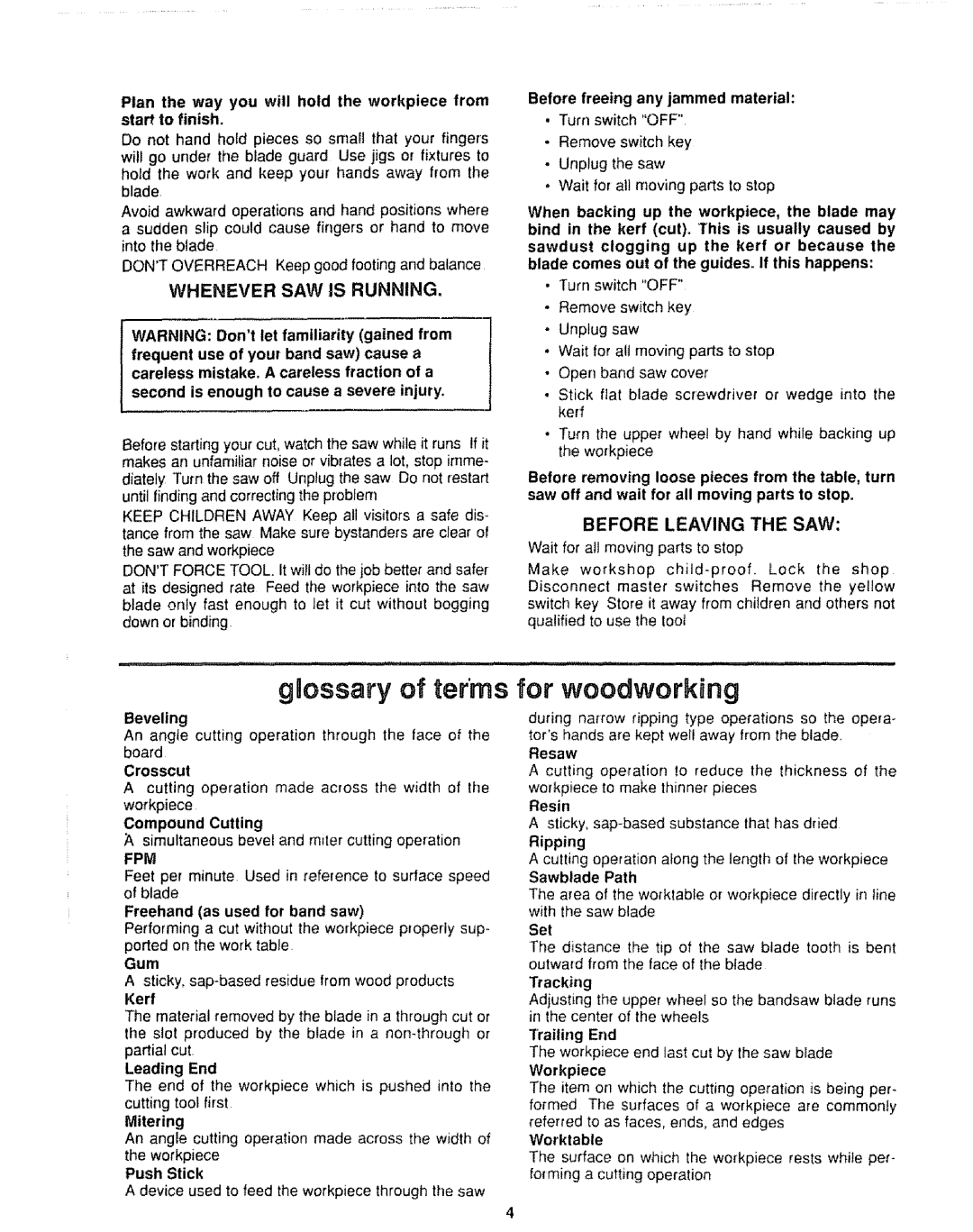
Plan the way you will hold the workpiece from start to finish,
Do not hand hold pieces so small that your fingers
will go under the blade guard Use jigs or fixtures to hold the work and keep your hands away from the blade
Avoid awkward operations and hand positions where a sudden slip could cause fingers or hand to move into the blade
DON'TOVERREACH Keep good footing and balance
WHENEVER SAW IS RUNNING.
WARNING: Don't let familiarity (gained from
frequent use of your band saw) cause a careless mistake. A careless fraction of a
second is enough to cause a severe injury.
Before starting your cut, watch the saw while it runs If it makes an unfamiliar noise or vibrates a tot, stop imme- diately Turn the saw off Unplug the saw Do not restart until finding and correcting the problem
KEEP CHILDREN AWAY Keep all visitors a safe dis- tance from the saw Make sure bystanders are clear of the saw and workpiece
DON'TFORCE TOOL. It will do the job better and safer at its designed rate Feed the workpiece into the saw blade only fast enough to let it cut without bogging down or binding
Before freeing any jammed material:
•Turn switch "OFF"
•Remove switch key
. Unplug the saw
. Wait for all moving parts to stop
When backing up the workpiece, the blade may bind in the kerf (cut). This is usually caused by
sawdust clogging up the kerr or because the blade comes out of the guides. If this happens:
•Turn switch "OFF"
°Remove switch key
•Unplug saw
•Wait for all moving parts to stop
•Open band saw cover
•Stick flat blade screwdriver or wedge into the kerf
•Turn the upper wheel by hand while backing up the workpiece
Before removing loose pieces from the table, turn saw off and wait for all moving parts to stop.
BEFORE LEAVING THE SAW:
Wait for a!l moving parts to stop
Make workshop
gnossaty of terms
Beveling
An angle cutting operation through the face of the board
Crosscut
A cutting operation made across the width of the workpiece
Compound Cutting
Asimultaneous bevel and miter cutting operation
FPM
Feet per minute Used in reference to surface speed of blade
Freehand (as used for band saw)
Performing a cut without the workpiece properly sup- ported on the work table
Gum
A sticky,
The material removed by the blade in a through cut or the slot produced by the blade in a
Leading End
The end of the workpiece which is pushed into the cutting tool first
Mitering
An angle cutting operation made across the width of the workpiece
Push Stick
A device used to feed the workpiece through the saw
for woodworking
during narrow ripping type operations so the opera- tot'shands are kept well away from the blade.
Resaw
A cutting operation to reduce the thickness of the workpiece to make thinner pieces
Resin
A sticky,
A cutting operation along the length of the workpiece Sawblade Path
The area of the worktable or workpiece directly in line with the saw blade
Set
The distance the tip of the saw blade tooth is bent outward from the face of the blade
Tracking
Adjusting the upper wheel so the bandsaw blade runs in the center of the wheels
Trailing End
The workpiece end last cut by the saw blade Workpiece
The item or] which the cutting operation is being per- formed The surfaces of a workpiece are commonly referred to as faces, ends, and edges
Worktable
The surface on which the wofkpiece rests while per- forming a cutting operation
